Home made Indian Clubs
A few days ago, I sent Paul Taras Wolkowinski an email, telling him about my home made Indian Clubs. He invited me to do a feature on his web site. I am a show and tell kind of guy. I like to illustrate everything with lots of visual aids. So here are some picture and video.
My name is Andrew Vogelsang. I live in Durban, South Africa. Durban enjoys a sub-tropical climate. January is the hottest time of the year. That is why you will see me running around like a half-naked savage in some of the videos and pictures.
In September of last year, I read a blog written by Thierry Sanchez, describing the benefits of swinging Indian clubs. So I decided to make myself some clubs using plastic bottles, ping pong balls and dowel rods.
I am an industrial chemist, and work for a company that makes urea formaldehyde resins. So I filled the bottles with UF resin. But cement paste would work equally well.
I sliced the ping pong ball (like slicing a hard boiled egg) and filled it with an epoxy paste adhesive. I then pushed this on top of the dowel rod, and removed the epoxy that was squeezed out.
[hr]My first attempts to swing clubs were very awkward and clumsy. My wife (bless her) recorded these attempts for posterity.
Whenever I watch them, I think of the Portsmouth Sinfonia! (Google Portsmouth Sinfonia, and listen to some of their music. You will see what I mean!)
I found Paul’s video tutorials on how to do basic swings and transitions. These are the best instructions I have seen. I studied them diligently. I can now do many of the movements that he does. He is an excellent teacher! You can see me doing basic swings and transitions using the small clubs in the video, starts at 1.13.
The green clubs weigh about 1.5 kg. Soon after I made them, I recorded some video which starts at 4.40, the vision demonstrates how effective club swinging is for working the deltoids and trapezius muscles.
Coconut Wood Indian Clubs
Last week I had to cut down a 30 year old coconut palm in my garden. This is what the palm looked like in September 2013.
I have always admired the coco wood flooring I have seen in hotels on tropical islands, and wondered whether I could use my palm to make Indian clubs.
| The wood from palms is very different compared to that from trees. Palms do not have annual growth rings. They grow from the inside out. The core is soft, like carrots or potatoes. When it dries, it has a very low density. The outer part is hard and tough, like marine plywood. When it dries, it has a very high density. A tree on the other hand, grows from just beneath the bark. The inner wood (the heartwood) is essentially dead, i.e. it does not grow at all. The heartwood normally has a higher density than the sapwood. |
Most of the fibres in a palm are aligned parallel to the trunk (to resist bending forces). But there are layers of fibres that run at 45º to the trunk. These fibres resist the twisting movement the palm is subjected to when the wind blows unevenly on the canopy. These fibres cause trouble when carving palm wood.
Here you can see my coco clubs after rough shaping. I have to wait for the clubs to attain equilibrium moisture content, before doing the final shaping, sanding and varnishing.
The clubs on the far right are actually bits of broom handle. I use them for practicing moves before committing to heavier clubs. But they are too long to practice fancy moves, because I sometimes hit myself in the head. I needed a pair of short, light clubs for that. So I focused my attention on the small clubs, (the pair next to the broom handles) and weighed them every day until they stopped losing weight.
I did the final shaping and sanding. I used an old triple beam balance to ensure that both clubs had approximately the same weight after shaping and sanding.
One club weighed 322 grams, the other weighed 325 grams. They are about 400 mm in length.
This is what they look like after a coat of varnish. The clubs look like they are made out of two different woods.
The left hand picture shows the side that was closest to the core. It has a very dramatic and handsome grain pattern. The large fibres have a silvery blond appearance in sunlight. As you tilt the club, the appearance changes, like tiger’s eye. The transition is from silvery blond to a light grey. This optical effect is called chatoyance.
I turned the clubs through 180º on their axes and took the right hand picture. Here you can see the side that faced the outside of the trunk. It has a finer grain that runs parallel to the direction of the club. It does not show the tiger’s eye effect of the other side.
The two pictures on the above show the tiger’s eye effect as the club is tilted to catch light. The change is from a pale grey (or grey brown) to a silvery blond.
When the high density side is tilted to catch the light, some fibres that have penetrated the surface become reflective. The effect is like the eyes on a peacock’s tail!
The remaining 2 pairs of clubs have a primitive savage kind of feel to them. Maybe I will leave them as they are. They are quite comfortable to swing, even the ones with the octagonal shape. I will use them on those days I pretend to be a cave man. Rawrr!
Footnote: A few months ago, when I knew I was hooked, I asked Mike Simpson to make me a pair of Izzy Barish Replica clubs – the IB2 and IB3 in his catalogue. I asked him to send the clubs to my daughter in London, which he did. She will be returning to South Africa at the end of this month, and will bring the clubs back in a container with her other possessions. So I should have some real clubs to play around with soon!
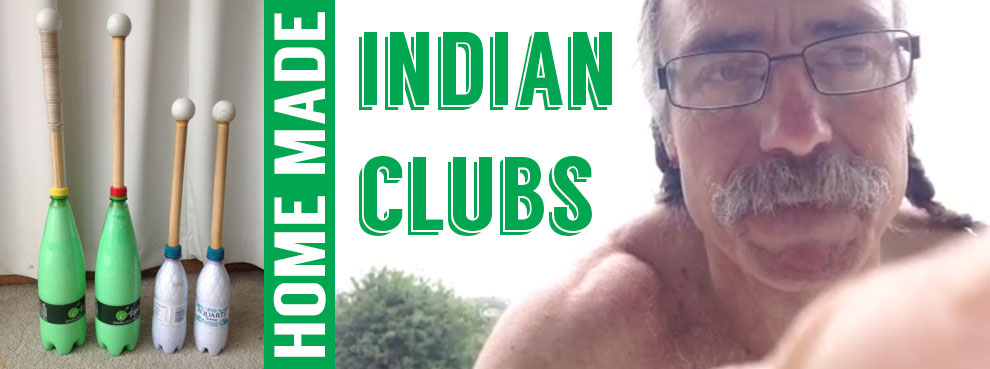
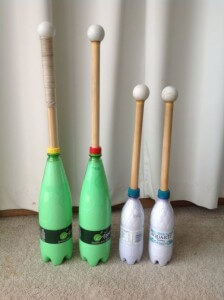
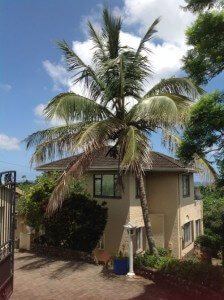
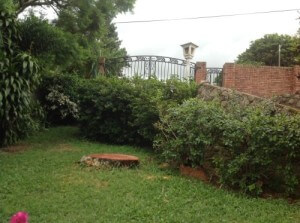
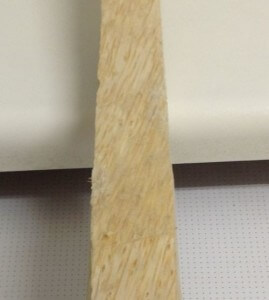
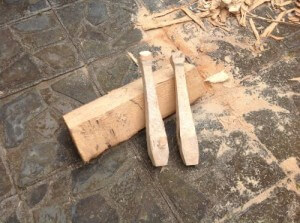
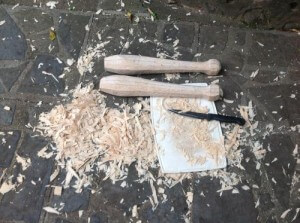
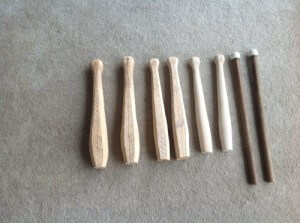
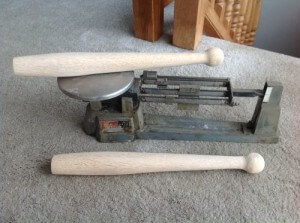
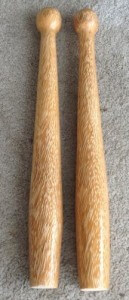
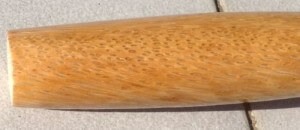
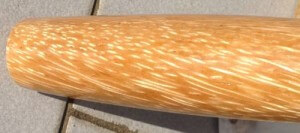
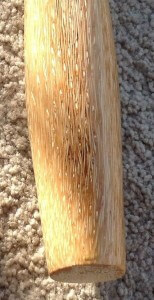
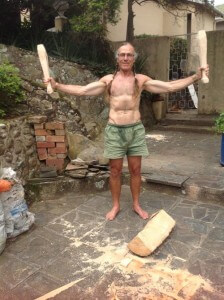
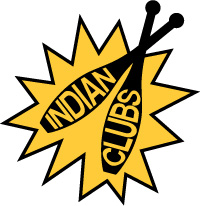
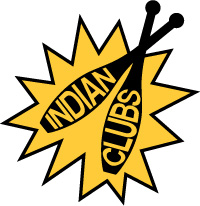
Way to go Andrew for 4 months practice! All the best!
Thank you for your kind words, Thierry. When I first read your blog, I was intrigued (and a little skeptical) of the mental benefits you claimed for swinging Indian clubs. Now I am convinced that you are right. I have found six cross crawl exercises that can be seamlessly integrated with club swinging movements. These exercises have the benefit of working the abdominal and oblique muscles, and to a lesser extent, the erector spinae muscles. If anybody is interested, I can write an instructional, and take photos and make a video to illustrate the exercises.
Andrew, the transformation from the very first scene in your video to the smooth swinging that you do with your small clubs is remarkable! I would love to see the exercises you speak of.
Thanks for the write up, it was interesting. I made my first set of clubs out of plastic children’s baseball bat set. The bats are hollow, so I filled them up with fine sand. They are just under a pound each. They do the trick, though not quite as satisfying as carving out your own set from a tree in your backyard I imagine.
Hi Andrew, Always interested in seeing different exercises. Would be great to see a video. Finally a big thank you for this article.
Andrew, absolutely, it’d be awesome! I have a student who has Parkinsons and he loves traiing with clubs especially because of the body mind connection involved with the cross crawl patterns.
Great minds think alike, I made some using a very similar technique. Instead of resin I used sand and I fixed the dowel through the bottom of the bottle with a screw. For the button I used lots of wraps of electrical insulation tape which I carried on down the handle to secure the dowel at the bottle neck too.
Hi Mike, I’d really like to see a photograph of your home made clubs, plus close ups of the ball and base.
If you can email me
paul@indianclubs.com.au
I will do just got to claim them back from my father. I’ll try and do some pics of other ones I’ve made too but I’ve just lost the venue were I used to train so a lot is now in storage for a few months.
Great, whenever you are ready, thanks for the reply.
Hi Paul
Did you get my email?
I have muscle imbalances due to a weak lower trapezius, obliques and erector spinae. I would really appreciate it if you could tell me about this ‘cross crawl’ exercise Andrew.
Thanks
Hi Asif, I have sent Andrew an email regarding your question. I trust he will answer it in due course.
All the Best. Paul
Thanks Paul. I’ve only been club swinging for a week. I appreciate all the tutorials and links. The videos are very good. Asif
Hello Asif,
Sorry for the late reply. The cross crawl exercises I have developed are very different from traditional Indian club swinging. I think they might look a little out of place on Paul’s site. So I have created a site dedicated to these types of exercises. Here is the link:
http://www.cococlubs.weebly.com
My recommendation is to practice the basic swings illustrated in Paul’s tutorials. That’s always a good place to start. When you can do them comfortably, you can introduce some cross crawl elements. The cross crawl exercises are not as elegant or visually satisfying as traditional club swinging, but they are very effective. Be prepared for some strange looks!
Hello, from Rio de Janeiro, Andrew! Thank you for posting your accomplishments in making your fine clubs and meels! My friend, Julio Diniz, and I have been inspired by your videos and photos and have begun constructing our own hand-made Indian clubs. Some of our very first models are viewable on the Indian Clubs Brasil page on Facebook.
Please keep doing what you’re doing! All the best,
Frank Colón
Thanks for your kind words, Frank. It is always gratifying to see others follow the same path that I have taken.
I am very impressed with the clubs that you and Julio have made. I cheat, by making my clubs while the wood is still wet and easy to work. But your clubs were made out of what appears to be kiln dried lumber, extremely hard and difficult to work.
Hello, Andrew!
Wow… I feel so honored that you and Paul are communicating with me! thank you for your kind words concerning our first attempts at Club carving!
So far, both Julio and myself have obtained our lumber from a commercial lumber yard…one that is close to Julio’s home. We have chosen Maçaranduba wood, as it’s very hard and durable and naturally beautiful. But, ever since I’ve been following your Club and Meel production methods, I’ve refined my eyes and now seem to notice all kinds of felled tree trunks wherever I happen to go…
As I shared with Paul, I’ve become enamored with the shape of the traditional Sim. Kehoe model of Clubs and will be attempting to fashion a pair (or three…) of replicas by hand very soon! I’ve noticed a recent FBook friend, Mike Romiski, turning out some fine clubs and I have also begun to research this method of carving wood….. which seems to be a “lost art” over here in Rio de Janeiro! For my next Sim. Kehoe Clubs, I plan to use some Maçaranduba or Jacarandá hardwood, which I can find here cut into “columns” measuring 15 x 15 cm!
But, let me tell you…. we’ve also been impressed with the way that you are expanding the swinging techniques so as to incorporate the entire body – upper and lower – at the same time that this becomes an efective intense interval aerobic exercise, as well!
Speaking for myself, although quite used to physical training, I’m still a crawling infant in the Indian Club Swinging Dept., but as soon as I practice more, I’ll be filming some moves and sending a clip to you guys, with your permission, for your evaluation…ok?
Thank you very much, Andrew and Paul, for your encouragement!
Cheers!
Frank
Hi Frank,
I have passed your message onto Andreas, and hopefully he’ll get back to you.
Paul
Hi, Paul!
Hey, thanks a lot, friend!
Best,
Frank